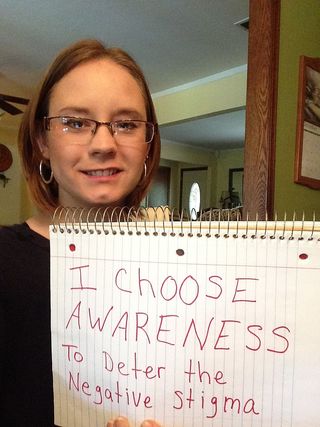Health
How We Interfere with Our Own Mental Health Care
Stigma is a major deterrent to mental health care.
Posted October 5, 2019 Reviewed by Devon Frye
While many are aware of the national problem of poor mental health care, how might we as individuals and as a society be contributing to it? We do so in spades by stigmatizing those who suffer from mental health problems.

Stigma is a negative emotional (attitudinal) reaction to a person or to their situation, one we're often unaware of—even as we're acting on it. Beyond negative emotional reactions to others, stigma also reflects our need to categorize things, creating the sometimes harmful “self-other” dichotomy.
Erving Goffman described three categories of stigma:
- aberrations of the body (short/tall)
- tribal (race, religion)
- character blemishes, which includes mental disorders and everyday emotionality1
Gordon Allport, on the other hand, identified the closely related concept of prejudice.2 Most now believe that prejudice is the unrecognized negative emotional or attitudinal component of the stigmatizing process. One of the least discussed ways in which prejudice is expressed is in how we stigmatize people with mental health problems.
What’s the problem? Often unaware, we view the stigmatized person with a mental disorder as quite unlike ourselves, sometimes not quite human. This skewed perception leads to discrimination and diminution of the person’s opportunities as they are labeled, for example, as inadequate or even dangerous. Shame, victimization, alienation, and plummeting self-esteem increasingly infect and dehumanize the unhappy person. Indeed, the discrimination against the person is often more deleterious than the mental condition itself.
Where did this negative perception arise? And why do we stigmatize people with mental health problems?
The dehumanization of the mentally ill can be traced to the 17th century, when medicine and science permanently exiled the personal and emotional aspects of humanity from its purview. In a ripple effect, individuals and society followed suit.3 Eighteenth century philosophers, especially Hobbes and Locke, applied mechanistic principles to our human nature. Reason and rationality prevailed during this appropriately named Age of Reason.4
By the 19th century, the mechanistic idea permeated society so much that it devalued all subjective phenomena, especially emotional and mental issues.3 This view was so pervasive that the mechanistic approach extended to government and economics. Just as the Cartesian influence on medicine benefits us to this very day, the Age of Reason inculcated individualism, property rights, free markets, and representative government.3
However, our stigmatizing biases sprung unintended from this time, like ugly weeds, progressively distracting from what had begun as a beautiful garden. The mind and emotions banished, society and its individuals gravitated to the objective and measurable. Because they flouted the basic precepts of the Age of Reason, patients with mental disorders were viewed as unreasonable, irrational, and “mad.”4 The mind was internal, inaccessible to rational evaluation and understanding. Stigma for all emotional and mental issues had become cemented into the culture in the 18th and 19th centuries so that it lurks in the subconscious of us all, stealthily infiltrating our psyches to this very day.
Stigma, once established, has far-reaching consequences. For example, Thomas Eagleton’s forced withdrawal as a Vice-Presidential candidate in 1972 illustrates the damaging effects of stigma. Eagleton had been selected by George McGovern as his running mate, despite his having been depressed in the past. Democratic operatives feared the public’s negative reactions and forced him to withdraw, concerned that the public would view him as weak and unstable. That’s stigma.
But stigma isn’t limited to people in the public eye. It’s right here in our own lives. Haven’t you heard someone say of another who is still grieving after a year that the bereaved is being a martyr, weak, or wallowing in self-pity? Or that someone with an anxiety disorder should just "calm down"? We do it all the time. And we don’t just stigmatize adults—we stigmatize children, too.5 One-third of people would not want their own child to befriend a depressed child, and one-half believe that depression treatment would produce negative effects on the child’s future.
Given these stigmatizing attitudes and behaviors, depressed patients begin to stigmatize themselves and avoid care, and many expect depression to have an adverse impact on their friends and a negative effect on their employment. Depressed patients even avoid care because they expect that the physician is not interested. Indeed, there is a high rate of stigma toward mental health patients by healthcare workers—for example, nurses have even more negative responses to alcoholics than physicians. The medical profession is not immune to self-stigma, either. Depressed medical students, a common occurrence, believed other students would think adversely of them and that treatment was unacceptable.

Not only do stigma and public attitudes need to be changed, but so also do many of our laws, regulations, and policies reflecting stigma.5 Recall the arduous process the disabled community (or LGBT or sexually abused communities) has undergone in order to achieve a modicum of success in making their lives more acceptable. Nonetheless, these efforts have been encouraging, leading to helpful interventions to improve public knowledge about their lives.6 In the academic world, where emotions were formerly dismissed, cognitive psychology has led by recognizing the paramount role of emotions in effective thinking and for rationality.
What can we as individuals do? We must shift our attention to the unique attributes of the stigmatized person, rather than focusing on their mental health category.7 To achieve this shift, however, social and emotional intelligence requires that we become aware of our own stigmatizing emotions and learn ways to become fully conscious of them. Mindfulness meditation has been useful in this regard. Once we become more clearly aware of our biases, we can make a better decision to act—or not—on our stigmatizing reactions.
By recognizing the cultural construction of stigmatizing the mentally ill, as well as its damaging effects, and reflecting on our own role in perpetuating this 17th century cultural relic, we will be able to take the first steps toward mitigating the suffering of those battling the social stigma of having mental health problems. The problem may be social, but the remedy begins with us.
References
1. Goffman E. Stigma--Notes on the Management of Spoiled Identity. New York: Touchstone Book--Simon & Schuster Inc.; 1963.
2. Allport G. The Nature of Prejudice. Garden City, NJ: Doubleday; 1954.
3. Capra F, Luisi P. The Systems View of Life -- A Unifying Vision: Cambridge University Press; 2014.
4. Porter R. Mental Illness. In: Porter R, ed. Cambridge History of Medicine. Cambridge: Cambridge University Press; 2011:238-59.
5. National Academies of Sciences E, and Medicine. Ending Discrimination Against People with Mental and Substance use Disorders -- The Evidence for Stigma Change. Washington, DC: National Academies Press; 2016.
6. Thornicroft G, Rose D, Kassam A, Sartorius N. Stigma: ignorance, prejudice or discrimination? Br J Psychiatry 2007;190:192-3.
7. Ito T, Urland G, Willadsen-Jensen E, Correll J. The Social Neuroscience of Stereotyping and Prejudice: Using Event-Related Brain Potentials to Study Social Perception. In: Cacioppo J, Visser P, Pickett C, eds. Social Neuroscience--People Thinking About Thinking People. Cambridge, MA: MIT Press; 2006.




